The Basics
FactSet’s Hierarchy suite of products provides a 360-degree view of a company’s diverse businesses. This unique multi-sector, variable-depth classification system groups companies based on their detailed product and service offerings, which results in a consistent, accurate, and flexible dataset. When fully expanded, the Hierarchy has over 7,000 sector and product groups providing the precision needed to truly understand companies in a multi-dimensional manner. The FactSet Revere Hierarchy provides the industry’s best answer to the question “What does a company do?”
There are three packages available in the Hierarchy suite:
- Hierarchy includes mappings for companies’ focus (primary) and ancillary lines of business and groups companies with up to three times the depth found in conventional industry classification systems. The product covers over 25,000 unique companies with multi-sector mappings and another 23,000+ companies with focus-only sector mapping.
- Hierarchy with Tradenames contains 300,000+ distinct product and services, including brands, which underline companies’ Hierarchy sector mappings.
- Hierarchy with Revenue includes company business segments mapped against the Revere Hierarchy taxonomy, which achieves, quantified, standardized, multi-sector exposure. The normalized data links business segment revenue and product categories to the FactSet Revere Hierarchy for over 45,000 unique companies.
The product information and content statistics contained in this document are as of July 2019.
The Coverage
The Hierarchy product suite offers various levels of coverage designed for specific use cases. The graphic below offers a side by side comparison of each. Hierarchy, Revenue, and Tradenames offer comprehensive coverage for a global universe of public companies. 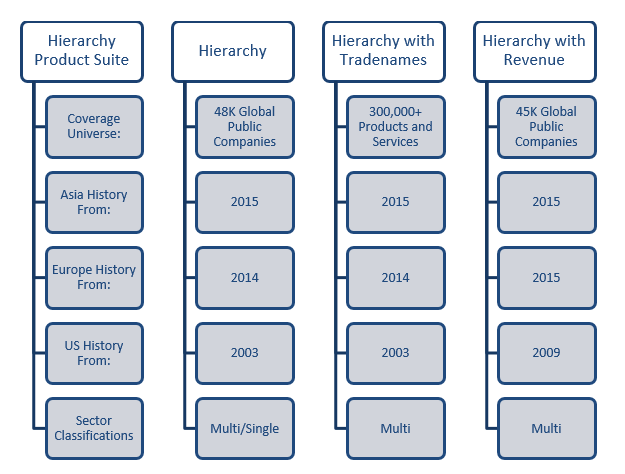
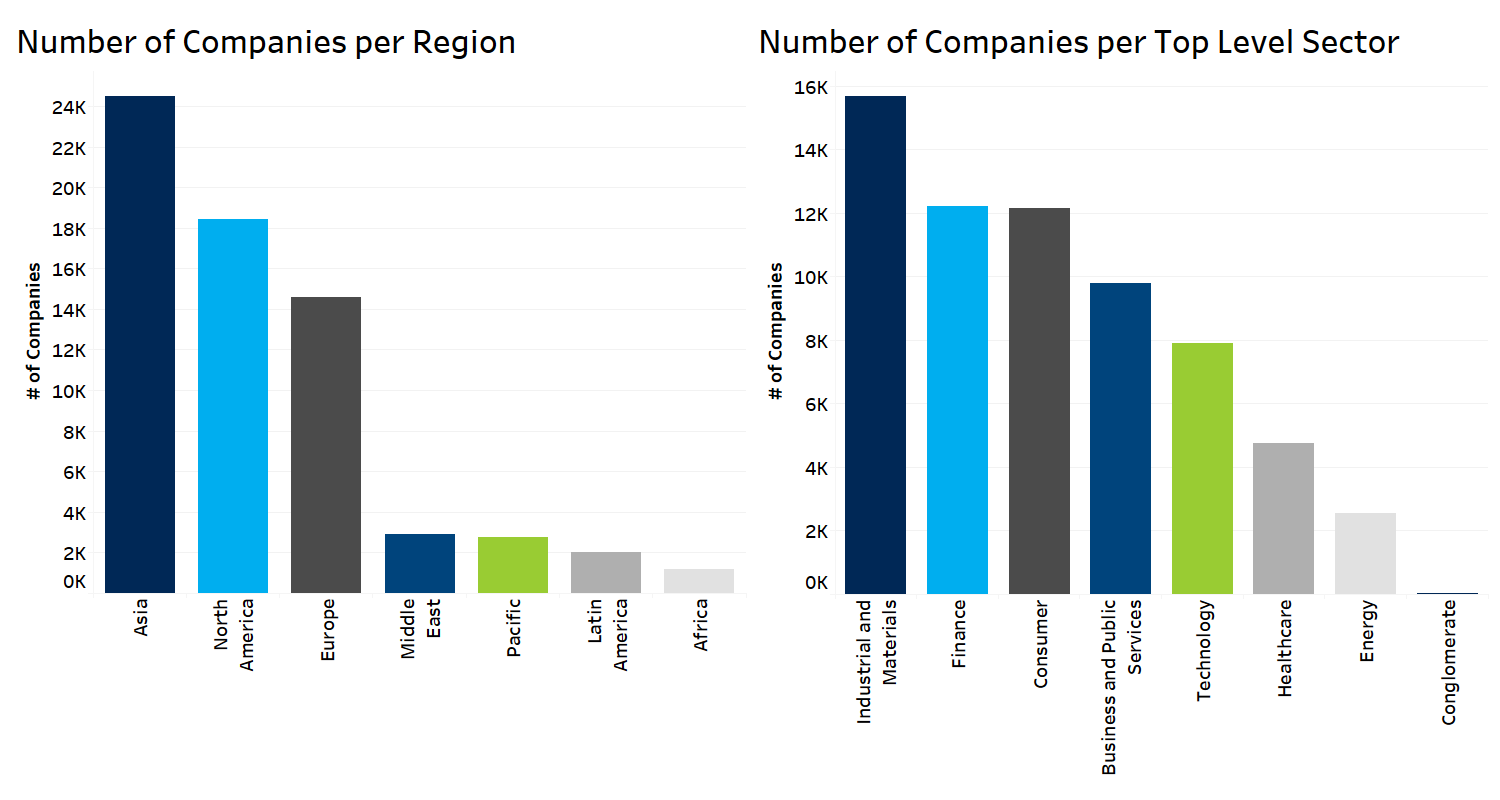 The Differentiators
The Differentiators
When classifying products and services instead of companies the best taxonomy emerges as one where industry groups accurately represent the competitive marketplace. FactSet calls this the “bottom-up” approach to classification. The result is a consistent, accurate, and flexible dataset that can take fragmented information and break it down into useful product and service categories.
Structural limitations of legacy classification systems (i.e. one-size-fits-all sectors) or narrowly focused methodologies (i.e. is Visa an IT company or a payment processing company?) handicap users in analyzing the full breadth and scope of a company’s businesses or identifying all participants in an industry vertical.
FactSet Revere Analysts collect and maintain the data required for the “bottom-up” approach. The group is divided into smaller teams, each specializing in an industry vertical. FactSet Revere analysts review primary source documents (e.g. annual reports/filings, investor presentations, company websites) of thousands of companies to catalog and map all material product and service offerings to the Hierarchy taxonomy. Analysts undergo extensive training and follow detailed methodology to interpret information in a consistent manner and input them into a data management system with built-in quality and error checking features.
Example Use Case
The FactSet Hierarchy DataFeed allows users to understand a company’s business involvement as thoroughly as possible, providing a much more detailed breakdown than traditional classification schemes. Using Olin Corp. as an example highlights the breadth and depth of the Hierarchy Taxonomy. Olin’s primary line of business (the Hierarchy Focus Sectors) Is Other Inorganic Chemicals in the Industrial and Materials – Chemicals – Commodity Chemicals – Inorganic Chemicals sector path. It also participates in a variety of other Industrial and Material sectors. The picture below shows the full breakdown of their business involvement.
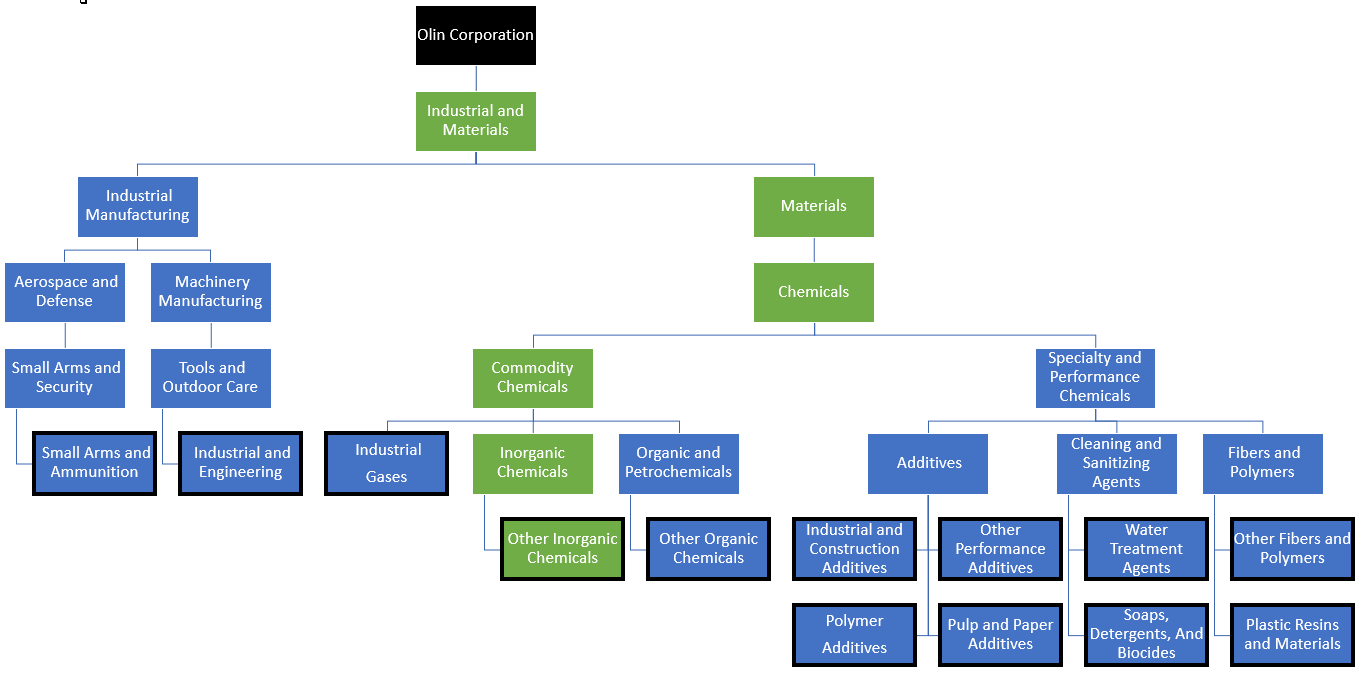
FactSet Hierarchy determines a company’s taxonomy based on the reported segment revenue data from the company’s filings alongside the tradenames for the products and services offered. This information can further illuminate where a company is generating its business. For Olin, there are 27 distinct tradenames currently offered by the company and each tradename is mapped to one, or more, sectors in the FactSet Hierarchy taxonomy. The example below shows Olin’s Other Inorganic Chemical Tradenames.
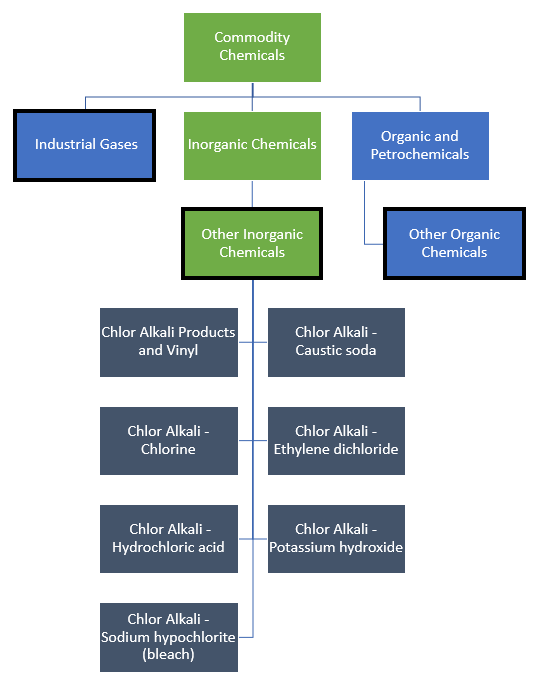
Olin also participates in the Small Arms and Ammunition sector with several Winchester branded Tradenames mapped to the node.
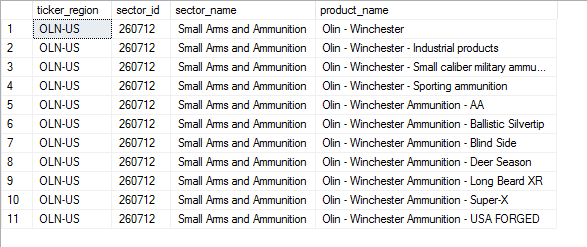
Traditional classification systems with a single-sector mapping structure would miss this component of Olin’s business involvement. The FactSet Hierarchy DataFeed makes it easy to identify companies that participate in sectors of interest despite being a secondary area of focus for the company.
The FactSet Hierarchy with Revenue package provides additional insight, mapping the company reported revenue segments to the FactSet Hierarchy taxonomy. Looking at the data for Olin, a user can identify that nearly 10% of the company’s revenue in 2018 came from the Winchester segment.

By standardizing and linking company reported tradenames and revenue segments to the FactSet Hierarchy Taxonomy, the burden of researching and understanding thousands of company’s complex business involvement is removed.
With this breadth and depth of coverage, the DataFeed also empowers users to perform a variety of ESG and SRI focused investment analysis. This includes positive and negative screening as well as identifying companies who participate in sectors aligned with the United Nations Sustainable Development Goals.
Additionally, users can understand the competitive balance in an industry. This is particularly useful in identifying those companies that may only derive a portion of their revenue from a specific sector while also representing a dominant player in that market. The Small Arms and Ammunition Sector provides a good example, as Hanwha Corp (~15%) and Olin (~9%) both receive relatively small portions of their revenue from the sector but are the top two players in the space.

The FactSet Hierarchy Taxonomy gives users an unparalleled view into a company’s business activities. By mapping Tradenames and Segment Revenue information to this variable-depth taxonomy users can get a 360-degree view of what a company does and where it makes its money.
If you have any questions or would like to learn more about any of the content mentioned above, please contact us at sales@factset.com.
Please visit the product page on the Open:FactSet Marketplace for more information: FactSet Hierarchy.









